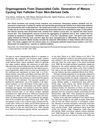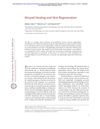Bioengineering Skin Using Mechanisms of Regeneration and Repair
August 2007
in “
Biomaterials
”
artificial skin synthetic biomaterials wound repair regeneration mechanisms fibrocytes wound healing skin regeneration growth factors TGF-ß VEGF PEG hydrogel hair follicle structures tissue-engineered replacement therapies transforming growth factor beta vascular endothelial growth factor polyethylene glycol hydrogel

TLDR Artificial skin development has challenges, but new materials and understanding cell behavior could improve tissue repair. Also, certain growth factors and hydrogel technology show promise for advanced skin replacement therapies.
The 2007 review "Bioengineering skin using mechanisms of regeneration and repair" discussed the progress and challenges in the development of artificial skin. Despite advancements, these skin substitutes often faced issues like poor integration, scarring, and lack of differentiated structures. The study highlighted the potential of new synthetic biomaterials in controlling wound repair and regeneration mechanisms. It also explored the role of fibrocytes, which constitute 10% of cells infiltrating wounds, in wound healing and skin regeneration. The researchers suggested that understanding fibrocyte behavior could lead to improved tissue repair therapies. Another study found that MRL/MpJ mice exhibited superior wound healing and regeneration capabilities, suggesting the importance of growth factors like TGF-ß and VEGF in wound healing. The researchers also experimented with PEG hydrogel technology to regenerate hair follicle structures in mice, indicating the potential of hydrogels in developing advanced tissue-engineered replacement therapies.




